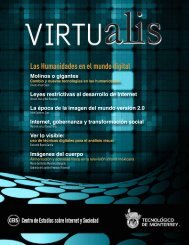P
terranova-network-culture
terranova-network-culture
- No tags were found...
Create successful ePaper yourself
Turn your PDF publications into a flip-book with our unique Google optimized e-Paper software.
Three Propositions on Informational Cultures 37ways that allowed the robot to interact directly with its environment(substituting the cognition box with a simple memory device). Theloop between sensor and motor organs allowed a more direct anddynamic interaction with the huge informational flows generatedeven by the most simple environment. Space becomes informationalnot so much when it is computed by a machine, but when itpresents an excess of sensory data, a radical indeterminacy in ourknowledge, and a nonlinear temporality involving a multiplicity ofmutating variables and different intersecting levels of observationand interaction. Space, that is, does not really need computers to beinformational even as computers make us aware of the informationaldimension as such. An informational space is inherently immersive,excessive and dynamic: one cannot simply observe it, but becomesalmost unwittingly overpowered by it. It is not so much a threedimensional,perspectival space where subjects carry out actionsand relate to each other, but a field of displacements, mutationsand movements that do not support the actions of a subject, butdecompose it, recompose it and carry it along.An engagement with the technical and scientific genealogy of aconcept such as information, then, can be actively critical withoutdisacknowledging its power to give expression and visibility tosocial and physical processes. We are very aware of the linguisticand social constraints that overdetermine the formation of scientificknowledge, and yet we cannot deny it a dialogic relationship withnatural processes (as Ilya Prigogine and Isabelle Stengers have putit). As it informs and doubles into the social, the physical world thatemerges out of this relationship is not passive, immutable, or evenunknowable, but probabilistic, chaotic, indeterminate and open.As I have described it, information is neither simply a physicaldomain nor a social construction, nor the content of a communicationact, nor an immaterial entity set to take over the real, but a specificreorientation of forms of power and modes of resistance. On theone hand, it is about a resistance to informational forms of poweras they involve techniques of manipulation and containment of thevirtuality of the social; and on the other hand, it implies a collectiveengagement with the potential of such informational flows as theydisplace culture and help us to see it as the site of a reinvention oflife. In every case, this reinvention today cannot really avoid thechallenge of informational milieus and topologies. In as much asthe network topos seems to match and embrace the turbulentinvolutions of such microcultural dynamics, the informational








